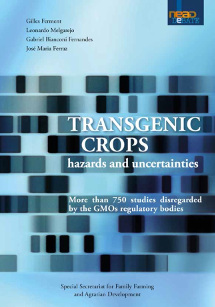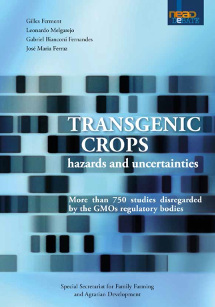Publication: Transgenic Crops – hazards and uncertainties

 For the fifth consecutive year, Brazil is considered as being the second largest producer of transgenic plants of the world, after the United States. The area for this type of culture already exceeded 40 million of hectares in our country.
For the fifth consecutive year, Brazil is considered as being the second largest producer of transgenic plants of the world, after the United States. The area for this type of culture already exceeded 40 million of hectares in our country.
The continuous increase of the area planted with transgenic soy, maize and cotton varieties, and the successive commercial release of new genetically modified organisms (GMOs), with combined alterated genes now, indicate the importance of monitoring their possible impacts to the environment, in general, and the human health, in particular.
With this respect, the Ministry of Agrarian Development (MDA) bring to the public this work which provides subsides to the qualification of risk evaluation processes associated to the growth of transgenic crops and to the consumption of their products and derivatives. The publication, intended to risk managers, researches, professionals from the biological, legal, economic and other areas, as well as to the other individuals interested on the subject, results from the Group of Agrobiodiversity Studies (GEA).
The extensive systematization work contained in this book gather references of scientific articles that are available for consultation via Internet, scientific publications or databank websites. The presented references correspond to studies published by independent researchers in magazines and indexed journals. Most of the articles can be accessed for free reading and download.
In more than 750 indications of texts from renowned research institutes established in several regions of the planet, scientists warn about the hazards and uncertainties involved in the massive environmental release of transgenic plants. By evidencing and documenting the absence of scientific consensus with respect to the transgenics impacts to the people’s health and to the social-ecological.
Transgenic Crops – hazards and uncertainties biodiversity, this book brings vast elements for the evaluation of problems resulting from the adoption of this type of biotechnology. The information here gathered reinforce the urgent need for critical analyses of the current agricultural and agrarian development model, opening the discussion for the search for alternatives for the rural environment and livelihood.
